French cavalry in the East. Part of 1. Leap on Pogradek
The actions of this cavalry, not consolidated in one unit, were originally limited to the region of Thessaloniki. Then they carried the police service against gangs of committees and, in addition, part of the regiments (1 and 8) was put into the trenches on Vardar. In fact, it was not until the summer of 1918 that it became possible to use this cavalry for its intended purpose. A division of African cavalry was formed as part of the 1 and 4 cavalry regiment and the regiment of spouses.
Edition “Armed Forces of Foreign States. Issue 4. Land forces of Belgium and France. " M., 1914. informs us (C.11.) that the French “Colonial cavalry consists solely of African units: 1) Regular cavalry in Algeria and Tunisia - 6 African cavalry regimental cavalry (chasseurs d'Afrique) and 5 of the regiments of spages (spahis); those and others have 5 (active) squadrons; horse rangers are completed exclusively by the French, and spagas - by the French and natives. Horse rangers are considered to be an excellent lightweight cavalry, but the spagues are mainly meant for action in Africa. ”
A series of beautiful tablets allows us to see African horse rangers (chasseurs) and the spouses of the pre-war period.
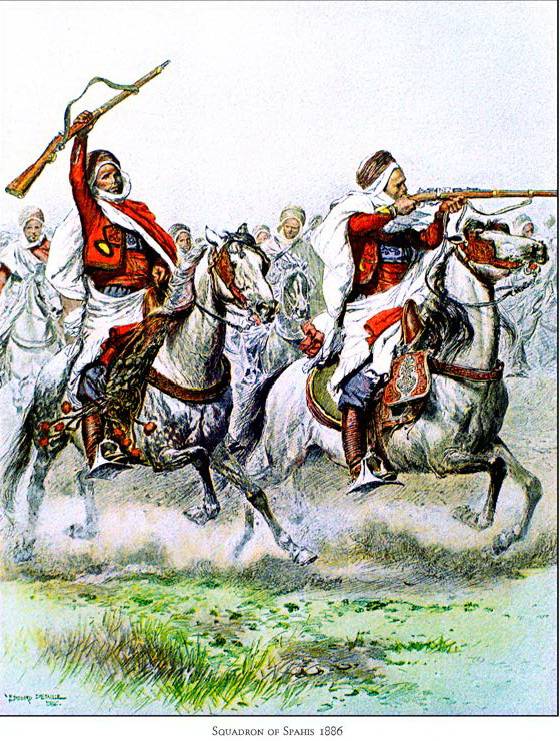
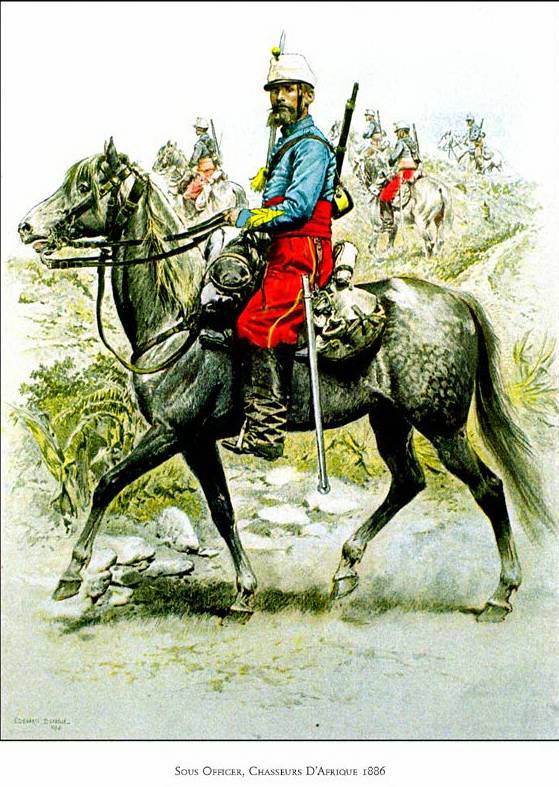
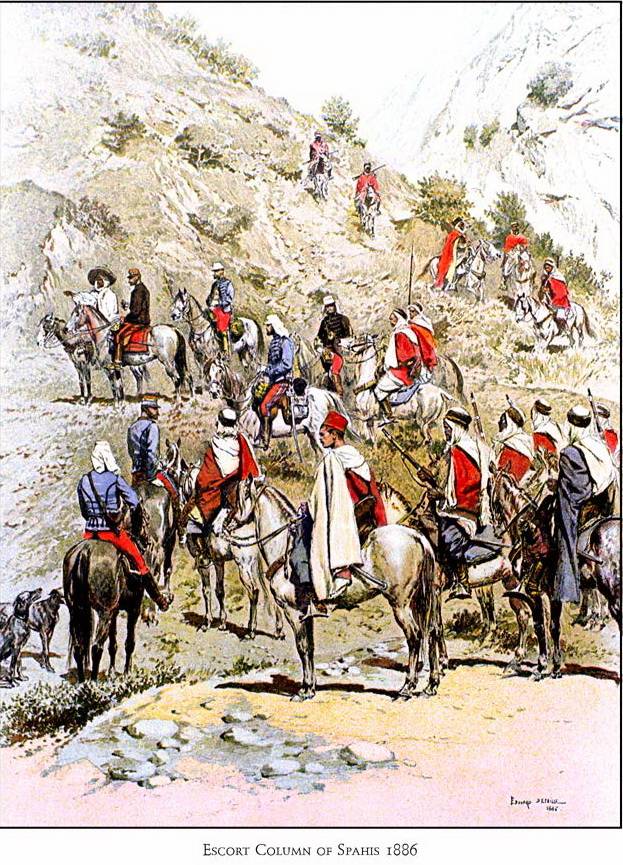
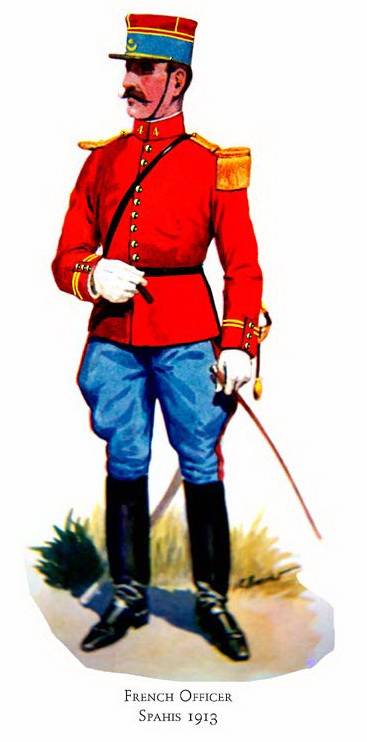
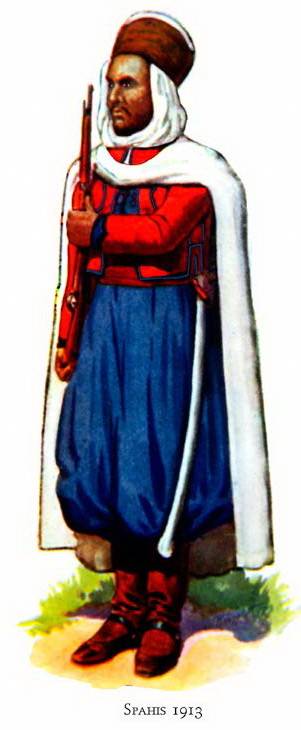
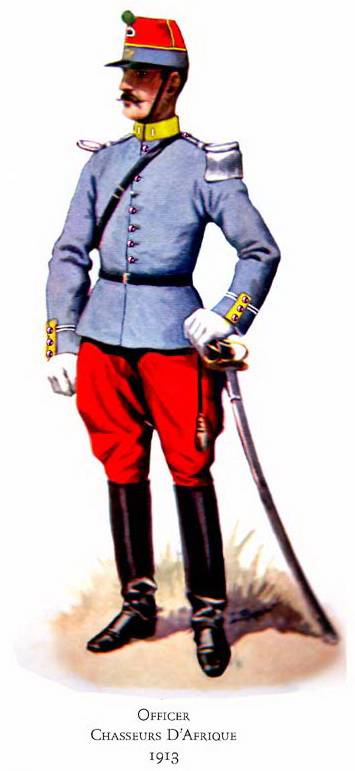
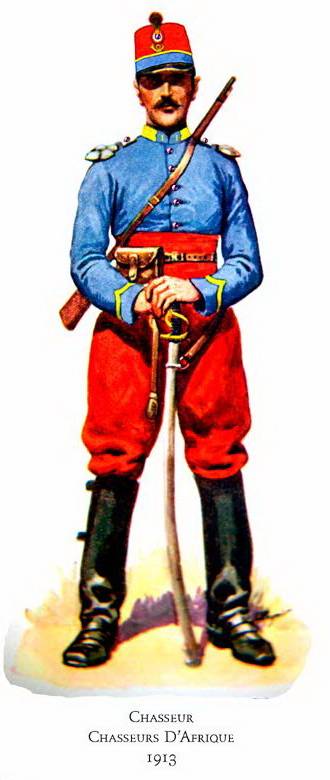
See the trumpeter 1 of the African horse rangers (ill. 2) and the soldier of the 4 th regiment of Moroccan spag (ill. 3) of the First World War we will be able to use the color reconstruction offered by Osprey Military - Sumner I., Embleton G. The French army 1914-1918.
And also Jouineau A. French army 1918.
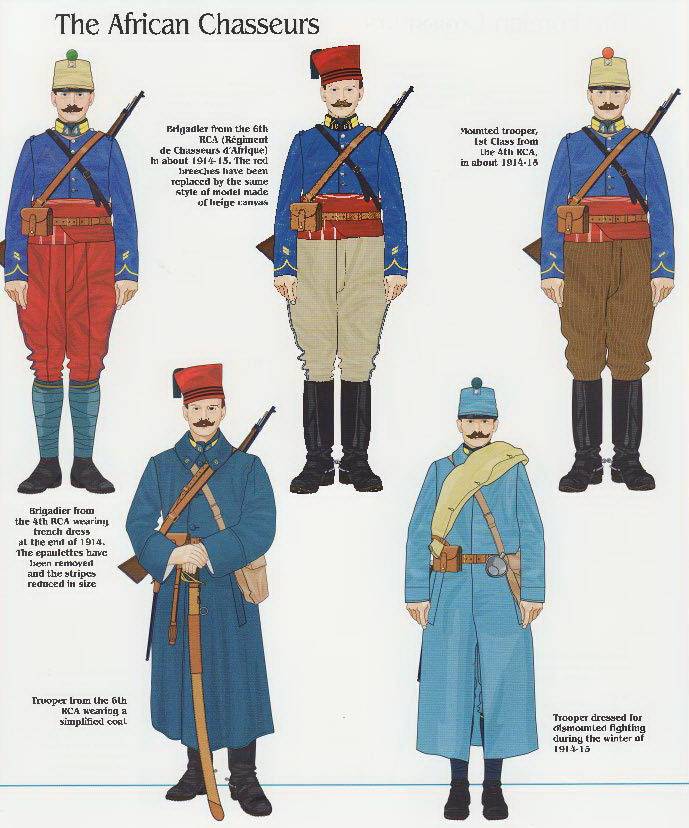
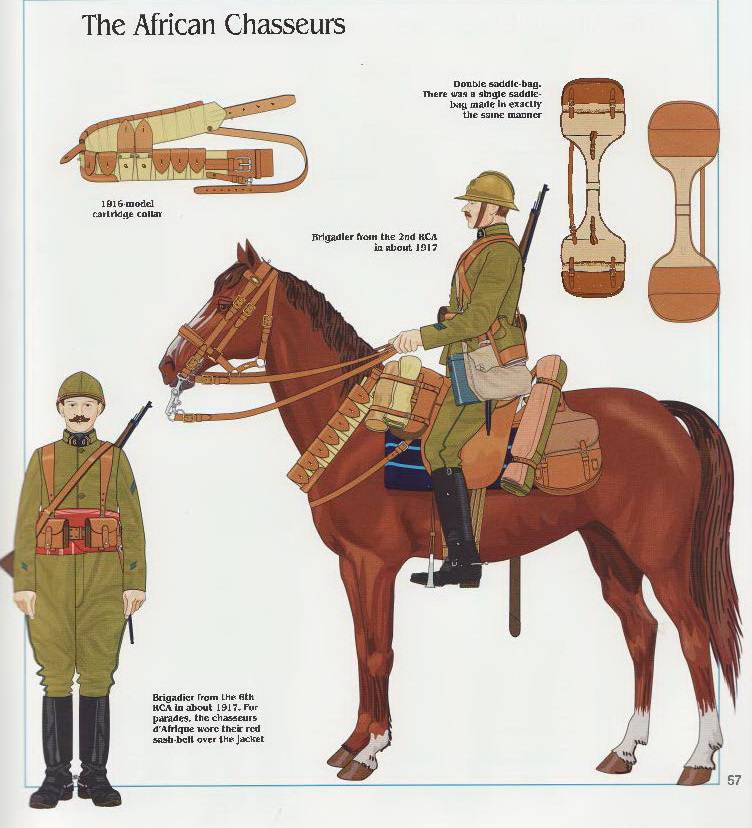
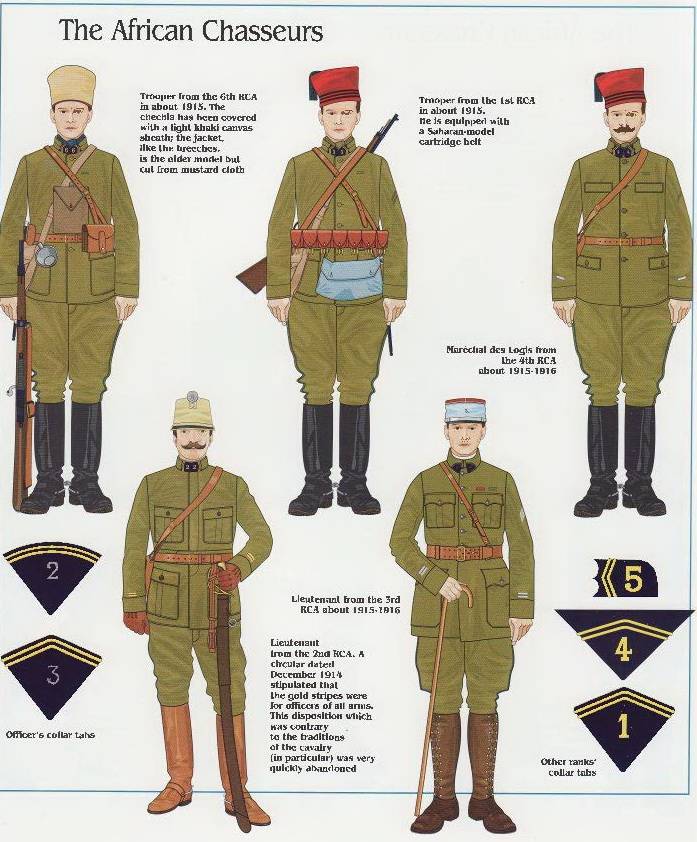
African horse rangers.
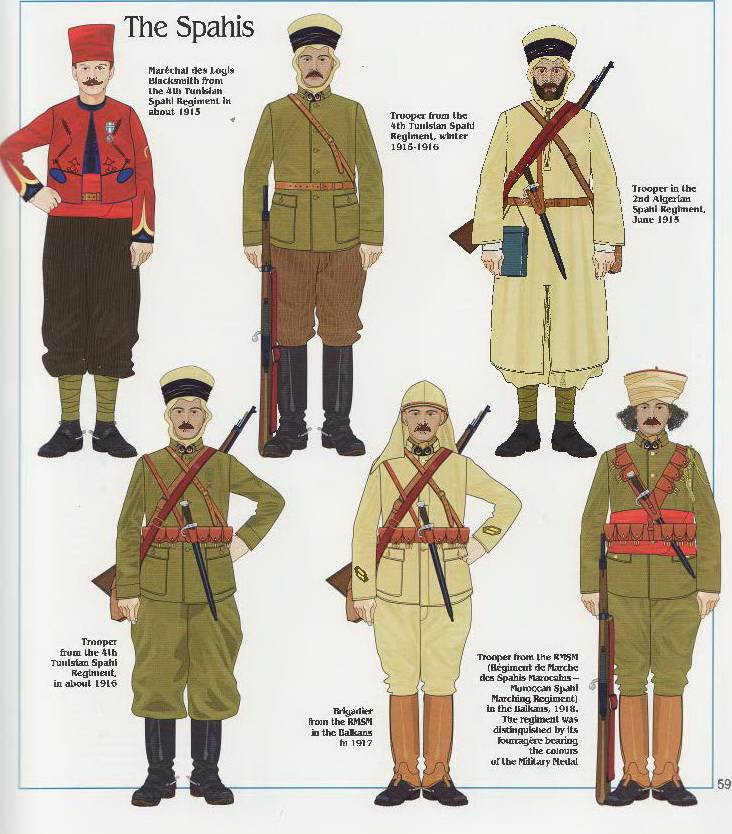
Spagi. Moroccan spagi is depicted in the lower right corner.
We return to the newly formed division. During this period, she was tasked with overseeing the withdrawal to the rear of the Russian Thessaloniki Division (2-I Special Infantry).
15 September, 1918, the troops of Thessaloniki front of the Entente went on the offensive. The division was sent to Prilep, and then it was sent to Uskub - to intercept the retreat of the German 11 Army, which continued to fight at the Monastery. After passing for four days (day and night, through the mountain ranges, along goat paths, having no other reserves than carrying in the saddle), the division left at the junction between the German 11 and Bulgarian 1 armies - and after a fierce battle, which she led in a combined (equestrian and on foot) formation, captured Uskub and captured the Kalkandele defile through which the German army retreated. The division had to hold the area for three days: performing an extremely important task on its own, without artillery - holding back a powerful enemy who tried to break through at any cost, just to avoid surrender. And the small French cavalry played a crucial strategic role. Later, she pursued the remnants of the enemy troops, making a twenty-day transition from the Morava Valley to the Tymok Valley and the Danube - from 2 to 21 in October 1918. And the Allied infantry fell far behind - and the cavalry had to rely only on themselves (the infantry approached only 10 November).
Thus, for the second time during the 1918 campaign (after the Palestinian campaign), the cavalry played a crucial strategic role - even in the conditions of a modern war. And the French authors even compare the cavalry of Thessaloniki front with Murat's cavalry.
But we will start with the events that took place a year earlier - we’ll tell you about the Offensive on Pogradek in September 1917.
Combat operations in Albania took place in a strongly mountainous area between Lake Ohrid, Lake Malik and the valleys of the Kelizoni, Devoli and Selsy rivers. This mountain range consisted of numerous mountain ranges with a height of 1500 - 2000 meters, and the chaotic intersection of steep slopes, gorges and rocks created great difficulties for the movement and actions of troops. The road network was in its infancy and in most cases was barely distinguishable trails. It was extremely difficult on such a terrain not only to operate, but also to supply with all necessary large military units, as well as to use numerous artillery. The defensive system of the troops of the German bloc on the Macedonian front ended at Gradista, south-west of Lake Malik. Starting from this point and up to the coast of the Adriatic Sea, Austro-Hungarians, hoping for the terrain, considered the possibility of offensive actions by the allies unreal. Accordingly, they limited themselves to the creation of a defensive system of outposts, supported by a few artillery.
On the other hand, enemy defenses between the lakes Malik and Ohrid, from the Hradists through Svirka, Gabrovitsa to Saint-Maum, were turned to the east. From this it followed that, in the event of a successful surprise attack, it was relatively easy to break through the line of enemy fortifications — moreover, the advance could be carried out at a considerable distance and without danger of being counterattacked by the enemy from the flank and rear. Austro-Hungarians were counting on the impossibility of a sudden attack - based on information obtained from Albanian spies and intelligence services, led by German officers.
The idea of an offensive operation flowed from the current situation.
The objectives of the attack were the following objects:
1. The area of Pogradek is the enemy’s base between the lakes of Ohrid and Malik.
2. Liberation from the enemy of the northern and western approaches to Pogradek in the lake district.
A temporarily formed division, divided into 2 groups, should have struck 2:
1) Main - from the area south of r. Devoli on Pogradek;
2) Auxiliary - from Bratomir, with the aim of eliminating the advanced enemy units and chaining his troops.
After the southern group reached the Svirn parallel, both groups, interacting with each other, had to attack in the direction of Velitern, Grabovitsa, Cherava - the line of heights covering the road to Pogradek.
Both strikes were supposed to make it possible to break through thoroughly fortified lines of trenches, occupied by strong units and supported by numerous artillery of different calibers. The secrecy of preparation for the offensive was very difficult.
The French planned and (in case of luck) a third attack - which has the task of reaching Devoli in order to gain a foothold at the heights between Devoli and Sels, and then advance to the line of the Kalina ridge dominating Pogradek from the north-west. Taking this line threatened the enemy’s rear communications: the road from Pogradek to Lin, the path through the mountain valley of Mackerel through Gelek.
The third attack was to be synchronized with a blow from the south.
The French command had to solve a serious task - to concentrate a significant maneuverable group, without arousing suspicion of the enemy.
The group consisted of:
5 squadrons and a company of machine guns of the 4 regiment of the Moroccan spagi;
The 49 Battalion of the Senegalese Riflemen, consisting of 3 Rifle and 1 machine-gun companies;
1 companies of the Albanian gendarmerie;
1 Mountain 65-mm Battery;
offices of wireless telegraph;
dressing squad.
The task assigned to the maneuver group was further complicated by the fact that in addition to the intelligence service that illuminated the area and numerous spies, the enemy had an excellent observation post at Gradista, which allowed observing during the day (using the Zeiss binoculars) any movement along the road from Biklist to Koritsa (up to individual carts, infantry, or horsemen). A aviation the enemy (base in Ohrid) was numerous, very active and also conducted reconnaissance.
The problem was solved as follows.
The district of Moskopol was chosen as a concentration zone for the detachment of Colonel de Forton. The Senegalese 49 Battalion, Albanian gendarmes and artillery were almost in place. These units took part in the cover of Koritz, along Kelizoni and on the heights of Schnom. The detachment’s main striking force — a Moroccan spagi regiment — was located on rest in the Bouf area, north-west of Florin - at a distance of 100 km from Moskopol. Spagas made from Buf 31 August at 0 hours.
On September 6, in the morning, they became a bivouac in a dense pine grove, where tents and horses were disguised from the observation of enemy aircraft. 7-th day was sent intelligence, and 8-th regiment was ready for the offensive. During the march, the regiment of the Moroccan Spagi twice, 3 and 4 of September, was seen by enemy aircraft in the Biklist region - where he stopped. In the course of the same day, 5, September, enemy aircraft lost sight of him - because at night he moved to Moskopol. On the night of September 8, the bivouacs collapse and the squadrons take up their starting position for the offensive.
Thus, thanks to the fast 100-km march in extremely rugged terrain, where movements in horse and on foot alternate with each other, 5 squadrons and 1 machine-gun company reached the point indicated by 5 days - and the movement was not opened by enemy aircraft. It was very important, since it was the equestrian mass that made up the main forces of the detachment, which was supposed to take possession of the enemy lines at the heights located behind the Devoli water barrier. Due to its mobility, this cavalry, consisting of fighters who did not know fatigue, was focused on the initial line, giving the command a great trump card - surprise.
The attack on foot began on September 8. The advancing units force the Devoli River between Kuskak and Trezova and consolidate at the Kraniski-Mukani line. The suddenness of the attack makes a huge impression on the enemy, disorienting the latter in the situation and contributing to success. The first part of the maneuver ends - and a period of success comes.
The 8 evening of September is carried out by the squadrons of spagas north of Desvik and Mukani. By the end of September 9, moving divisionally, after mastering the Osnad 1 Division, the spagi break up the bivouac north-west of Bragodus.
On the night of September 10, they reach Berdov (on the outskirts of Pogradek) and 11-s capture the city. Three days was enough to launch a successful offensive from 25 to 39 km.
The march of spags was the result of the skillful use of the mobility of winding horses - to increase speed of movement. Clockwork horses, the seeming burden interfering with the cavalry, provided the latter with invaluable help. With their help, the regiment of spags became even more mobile. Played this circumstance and role in the food issue. It was impossible to rely on the resources of the local population - a small number of Albanian settlements in the region had already been “cleaned up” by Albanian gangs and Austro-Hungarian troops. The guards with food and fodder, moving from the rear (Koritz-Voskop) with the aid of pack mules, were always late or did not come at all, not being able to follow quickly advancing units. The only way to partially resolve this issue was the availability of food and feed on packs. Horses had food packages for 5 days per person and horse (flour, canned meat, sugar, coffee, barley). With the help of these products squadrons were content until September 12.
Clockwork horses were broken into small columns — on 6 — 8 horses — connected to one another and going to the back of the head. Thus, they could follow in the footsteps of the regiment — and, in spite of unforeseen accidents, they performed important functions. This ensured successful resolution of supply issues. And the 4 th Regiment of Moroccan Spagi only increased its mobility.
During the entire operation to take control of Pogradek, the Moroccan spagi regiment fought exclusively on foot - every day it launched an offensive against the enemy infantry, which was heavily fortified with natural positions. At first he dealt with Albanian irregular units, disciplined and excellent shooters, who perfectly mastered the tactics of the mountain war. These units fought in close connection with Austro-Hungarian units, well equipped and with a large number of machine guns. Then I had to meet with the 12 Battalion of Saxon foot hunters, supported by units of dismounted German hussars. This personnel battalion was transported from Ohrid to Pogradek in motor boats on the night of September 9. At first he tried to stop the French offensive, and later his role was reduced to covering the rapid retreat of the Austro-Hungarians.
September 8 spagi, forcing the crossing to the river. Devoli, find Albanians and Austro-Hungarians, who occupy a number of heights on the right (dominant on 1200 meters) riverbank. The positions of the enemy were reinforced by trenches with loopholes - located in front of the villages of Kraniski and Mukani. From dawn until noon, the spagi remove the front posts of the enemy, climb steep slopes, take villages by storm and clear the ridge separating Devoli and Sels from the enemy. On September 9, the enemy is attempting to seize the initiative and put up resistance on the Dordozi-Osnad line. For this, he uses fortifications on flanking heights and numerous defiles in the wooded zone. He provides stubborn resistance, moving from trench to trench - conducting numerous counterattacks. The 12 th battalion of Saxon foot rangers appears on the battlefield by the end of the day - but despite this, the spags take possession of the enemy’s positions and hold in their hands the trenches they occupy.
On September 10, the spags overcome the approaches to Pogradek, protected by full-profile trenches (with the front both east and west). The enemy, supported by artillery, retreats, defending every piece of land. But the spags storm the trenches, reach Pogradek, and Grellt's squadron rushes into the city. The squadron, in spite of the fierce counterattack of the Saxons, who had stayed in the city at night, proceeded to storm the Sugarloaf peak, which dominates the city from the north and locks the road to Lin. This hill, reinforced by disguised trenches, represented an excellent stronghold for the 12 Saxon battalion.
In order to succeed, acting against the Albanians, Austro-Hungarians and Germans (foot rangers and hussars), the regiment of Moroccan spagas very often resorted to maneuver. As soon as the attackers ran across the center of resistance, the enemy was shackled from the front by automatic fire weapons and a very small amount of manpower, and the rest of the masses, maneuvering under the cover of fire, tried to bypass the enemy from the flanks. Maneuver in the conditions of the mountain war was reduced to finding and fast penetration into the defile and along the mountain paths - to the points leading to the flanks and even to the rear of the enemy's position.
Artillery support for the advancing squadrons took place only once - when crossing the river. Devoli covered by 65-mm mountain battery fire.
Light machine guns played a crucial role. In frontal attacks, they kept the most sensitive positions of enemy positions under fire and neutralized the fire of enemy machine guns. When reaching and following rounds, they accompanied reconnaissance groups, and as soon as a round or coverage of the enemy’s flank took place, they attacked the enemy’s flanks or rear.
The Vivan-Bessiere rifle-propelled grenade launchers fired from the depths of the battle order of the spags at the dead spaces and at the trench defenders located behind the battlements. Hand grenades were also used very widely - for stripping trenches and to repel counterattacks.
The operation in Pogradek is very indicative of the fact that it was not the direct fighting in the equestrian system that was of key importance, but the amazing maneuvering ability of the cavalry - enhanced by the use of clockwork horses. High speed, active maneuvering before the battle and in battle, initiative - brought a quick and brilliant victory over the Austro-Germans.
The brilliant success of the Moroccan spagi regiment was also explained by the excellent armament and equipment of the fighters, the skillful work of light machine guns and grenade launchers. The tactics of the mountain war showed that the massed use of heavy machine guns was not necessary - and the latter were used by branches and semi-regiments. Incidentally, if the spags had a machine gun company of the 3 platoon (2 machine gun in the compartment), then the African horse rangers had only 1 platoon of machine guns in the 2 compartments - but, having received the third machine gun, they came to the organization of spags.
The attack on Pogradek clearly demonstrated the capabilities of the modern cavalry in the conditions of the mountain war - a universal and mobile command resource. The operation entrusted to the regiment of Moroccan spags consisted of a quick forced march to the place of concentration and from the immediate offensive. The successful completion of the operation was due to the bright manifestation of the two main qualities of the cavalry: striking power and mobility. The elements of surprise were widely used - which also contributed to the overall success.
But it is necessary to take into account that a) the regiment of Moroccan spagi could better than any other part perform these combat missions - its officers and non-commissioned officers more than once made transitions in the Atlas mountains (similar to the mountains of Albania); b) Moroccan Spagi - excellent walkers in the mountains, extremely unpretentious in food, possessing a militant character. The Barbary horses in their ability to climb the mountains looked like goats: hardy and unpretentious, they were much more adaptable to work in mountainous conditions than awkward Normans or too hot Anglo-Arabs. And Arab saddles made it possible to quickly load weapons and food items.
The 5 squadrons and the machine-gun company in the standard composition allowed the regiment commander, using the 4 squadron in combat, to have a strong reserve. Moreover, the regiment guards always followed the fighting units during the battle - which, under the appropriate case, would allow conducting an attack in the equestrian ranks. And the French could be proud of their colonial cavalry, which defeated the strong parts of the enemy and solved an important operational task.
Продолжение следует ...
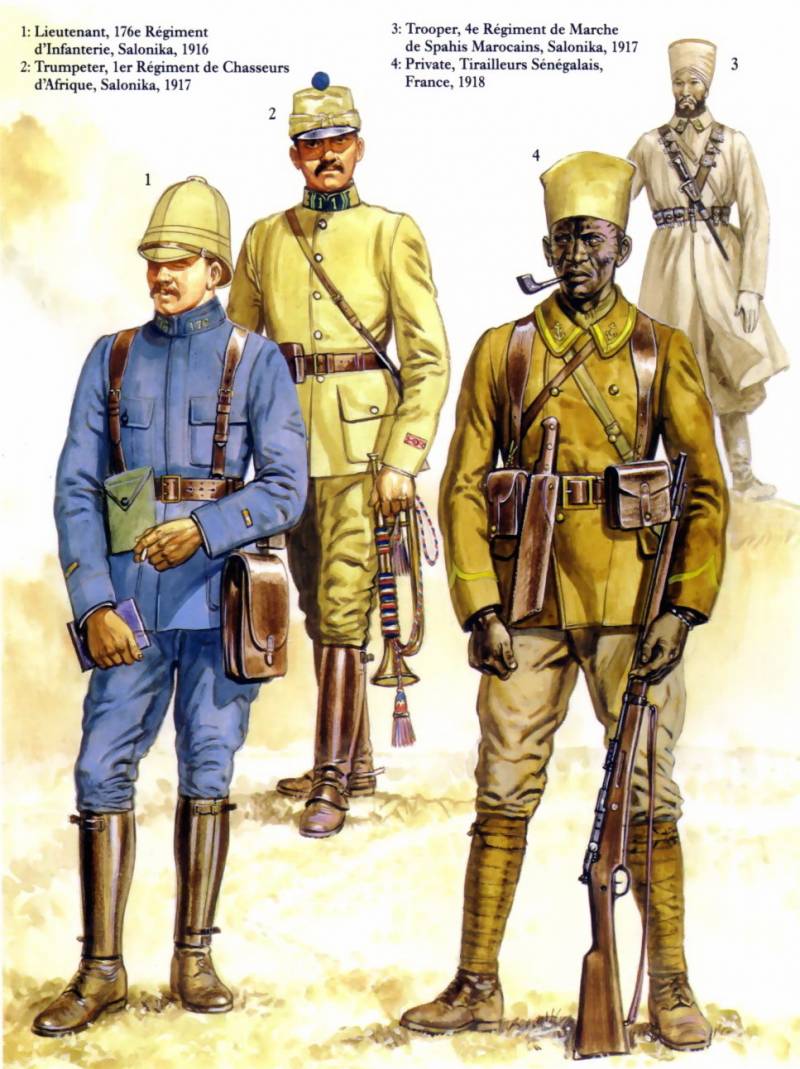
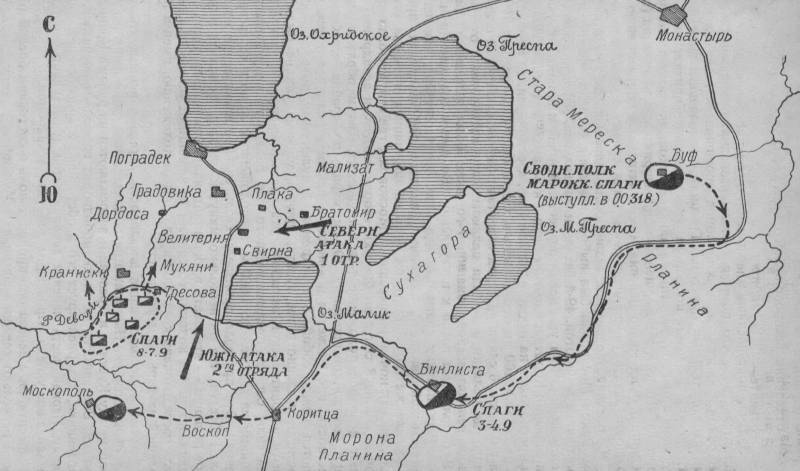
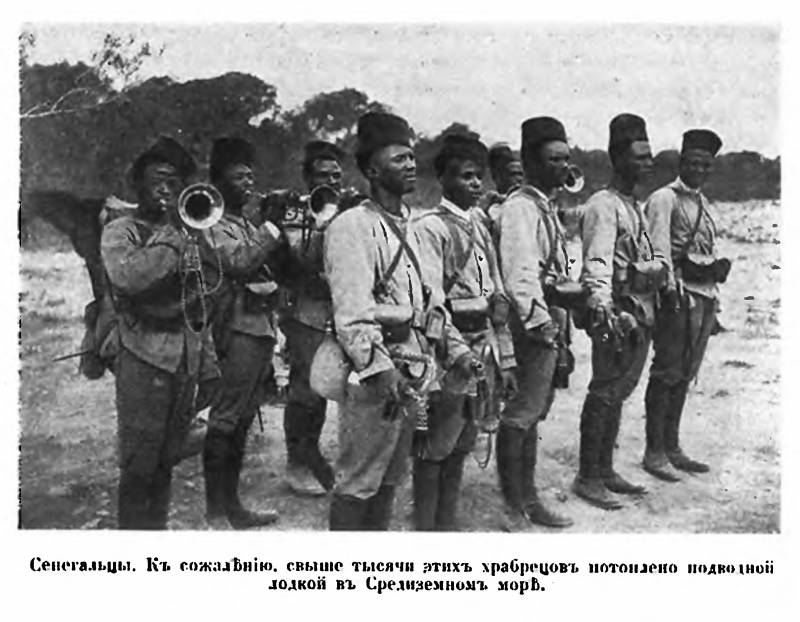
Information